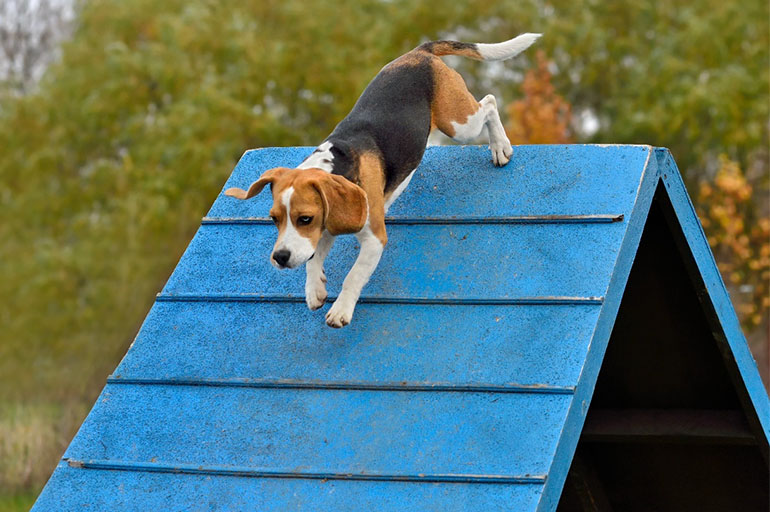
When setting up a backyard agility dog course or starting your dog’s training journey, choosing the right first obstacle can make all the difference. The dog agility A frame stands out as one of the most iconic and versatile pieces of dog agility equipment — but is it the ideal place to begin? In this article, we’ll explore the pros, potential challenges, and training value of the A-frame to help you decide if it should be your dog’s first step into agility.
Why We Love The Dog Agility A-Frame
The A-frame is more than just a standout feature—it’s a powerhouse training tool that brings multiple benefits to your dog’s agility journey.
First, the A-frame helps build physical strength, balance, and coordination as dogs learn to ascend and descend its steep surfaces. The incline challenges muscles in a way flat obstacles can’t, promoting overall fitness.
It also teaches focus and control, especially when practicing contact behavior at the bottom of the obstacle. Dogs must slow down, place their paws with precision, and follow cues—skills that translate to other parts of agility and everyday obedience.
Beyond the training benefits, the A-frame is just plain fun. Many dogs love the thrill of climbing and conquering it, and their excitement often becomes a source of motivation during practice.
Visually, the A-frame acts as a centerpiece for your backyard course. Its height and structure create a professional look and add variety to your setup, making your space feel like a true training ground. Whether you’re training for competition or just having fun, the A-frame earns its place as a foundational obstacle in any agility course.
Dog Agility A-Frame Training Tips
Introducing your dog to the A-frame should be a gradual and positive experience. Start with the obstacle at its lowest setting (if adjustable) to build confidence and comfort. Use treats or a target to guide your dog over the frame slowly, reinforcing calm, controlled movement.
Early in training, it’s important to focus on contact behavior—teaching your dog to touch the yellow contact zones at the bottom of each side. Many trainers teach a “2-on/2-off” behavior, where the dog stops with two front paws on the ground and two back paws on the A-frame. Others may opt for running contacts with careful stride training. Choose the method that best fits your dog’s speed, temperament, as well as your long-term agility goals.
Keep sessions short and rewarding. Stop before your dog gets tired or frustrated and always end on a positive note. Over time, gradually increase the height of the A-frame and introduce small challenges like handler movement and verbal cues to strengthen your dog’s understanding.
Safety Considerations for Backyard Use
While the dog agility A frame is a valuable training tool, safety should always come first. Start by placing the obstacle on level, stable ground with plenty of open space around it. Avoid positioning it near fences, trees, or hard surfaces like concrete.
Before each session, inspect the A-frame (and all other dog agility training equipment) for moisture, wear, or debris that could cause slipping. A non-slip surface is a must—especially if your dog is fast or the obstacle is set at full height.Train during cooler parts of the day and avoid sessions when your dog is overly tired. As with all agility equipment, supervise your dog closely and never push them past their comfort level. When introduced and used correctly, the dog agility A-frame will become a safe and enjoyable part of your dog’s agility routine.
How the A-Frame Complements Other Obstacles
The A-frame isn’t just impressive on its own—it fits beautifully into a well-rounded agility course. It transitions naturally between dog jumps, the dog tunnel, and weave poles, helping dogs learn how to change speed, shift focus, and follow directional cues.
Its steep incline and required contact behavior make it a strategic pause point in a course, allowing handlers to regroup or redirect. It also reinforces important skills like impulse control, which are critical when sequencing obstacles.
By including the A-frame in your backyard setup, you’re giving your dog more than just a climbing challenge—you’re helping them develop the confidence, coordination, and control needed to succeed across the entire course. Of course, if you wish to compete, you’ll find an agility A-frame on every official dog obstacle course, so it’s definitely a skill your dog will need to master. In the final analysis, while the a-frame can be an excellent starting obstacle, you can truly get started with any piece of dog agility equipment. Some people love to start with jumps while others prefer the a-frame or the tunnel. With agility, there’s really no wrong way to start, and the real goal of this popular dog sport is to simply have a great time with your dog and boost your bond.
Carlson Agility: Your Source For Quality Dog Training Equipment
At Carlson Agility, we have everything you need to set up your backyard course, including the dog agility a-frame, the agility dog walk, the pause table, agility weave poles, the dog agility teeter totter and all types of jumps, including the tire jump. We also carry a full selection of mini agility equipment, including a mini agility a-frame, which is ideal for small breeds.
In addition to our selection of agility equipment, we also carry K9 training equipment, which is the same apparatus used to train police dogs. We also sell nosework supplies and handy agility training tools. Our K9 and dog agility equipment is handmade and built to competition standards. Whether you are searching for a dog agility a frame, a teeter, dog walk or other equipment, we’ll provide you with durable, safe equipment your dogs will enjoy for years to come.





